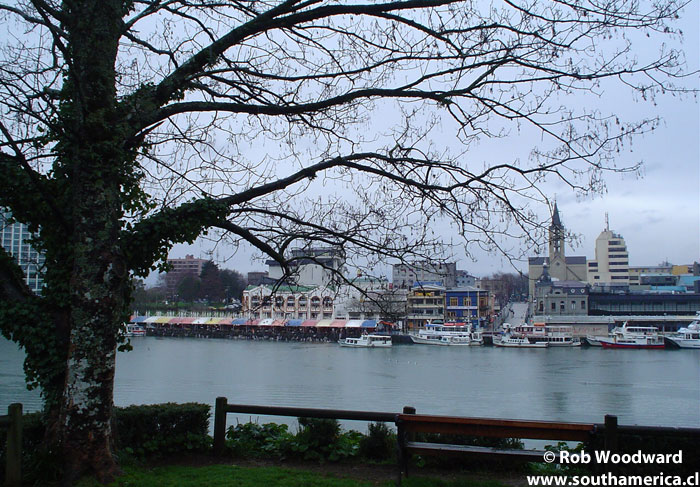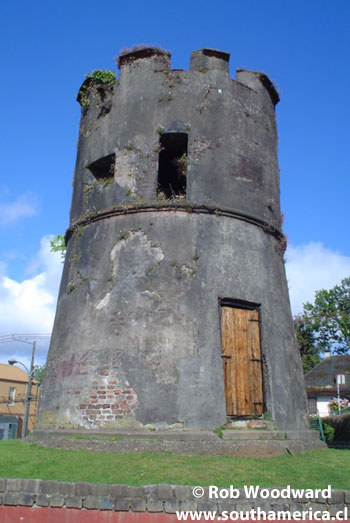Valdivia
Chile

Valdivia is a beautiful city of approximately 130,000 people that is 841km to the south of Santiago in the 10th region of Chile.
History of Valdivia
Valdivia was founded on the 9th of February, 1552. During the late 16th century, Valdivia was the second most important city of Chile but was abandoned in 1599 after Mapuche (the indigenous people of the region) hostilities. Over the next 50 or so years the Dutch settled in the area though without much success due to the local Mapuches again. It wasn't until 1645 that Valdivia was re-founded by the Viceroy of Peru and forts were built in Corral, Niebla, Mancera and the Cruces River. The ruins of these forts can still be seen and visited today.
In 1740, Valdivia came under the control of Chile and more fortifications were built along with many churches and government buildings. By the end of the 18th century, Valdivia was a very progressive city both socially and economically. An economic crisis settled in during the first three decades after the formation of the Chilean republic causing the city to lose its power and influence.
Between 1850 and 1875, the city (and the region) received a great intake of German immigrants. Many of the buildings and especially the houses have maintained a traditional German look about them since then. In fact, the German influence continues until this day with many Chileans in the area having German surnames or ancestry.
The World's strongest recorded Earthquake
At 3.40pm on 22 May 1960 Valdivia was hit by the strongest recorded earthquake in the world. The Earthquake measured 9.5 on the Richter Scale. Most of the buildings in the city were destroyed by the earth's movements or by the devastating tsunamis that followed. Not only were there catastrophic consequences in the South of Chile, the earthquake caused tsunamis that hit Japan (138 people killed), Hawaii (61 people killed) and the Philippines (32 people killed). At 3.11pm, a smaller earthquake was felt in the region and yet another 'smaller' earthquake of 7.5 the day before in Concepción a little to the north.

What to see and do in Valdivia
The 'Torreón del Barro' a defense tower built in 1781 by the riverside is now a national monument. It is on Av. Ramón Picarte.
Muelle Schuster (Muelle = wharf) and the Mercado Fluvial are one of the first places that you visit in Valdivia. Many sightseeing boats leave from Muelle Schuster, some more expensive than others.
The Mercado Fluvial is the main market of the area where boats come laden with all types of fish and other seafood. There are many restaurants offering tasty fresh dishes here. Prices vary a lot amongst the restaurants in the same building so make sure you have a look around first before being enticed in by a cheerful waiter at the door.
The cathedral of Valdivia is on the original site where a church was built in 16th century. The church had to be rebuilt 15 times due to fires, earthquakes and Mapuche raids. In the central nave of the cathedral you will find the Virgen del Rosario that was donated by King Felipe IV in 1645.
If you want to visit the fort of Niebla cheaply, take a 'colectivo' or collective taxi from between the Mercado Fluvial and the bridge that crosses to Isla Teja. That's what the locals do.
Isla Teja
La Universidad Austral de Chile is the local university is on Isla Teja just across the bridge from the main center. The university is strong in horticulture / botany / forestry careers and has its own botanical gardens which are free to stroll around. You can hire a guide if you wish to explain all the different types of plants, flowers and trees.
On the same island (it's so big it doesn't seem like one) is the Parque Saval which contains 30 hectares of flora and has two beautiful lagoons. There is a small entrance fee to enter this park.
Also on Isla Teja, right beside the river overlooking the main city is the Casa Anwandter. It is perched on a steep bank which is the only reason it didn't get flooded by the tsunamis of 1960 and is one of the few buildings that survived the earthquake. Casa Anwandter is a typical German colonial house from the 19th century that is now a museum. The rooms of the two-storey house are divided into different time periods of Valdivia's history.
Next to Casa Anwandter is the Museum of Contemporary Art which used to be the old Anwandter brewery.
Around Valdivia
Not far from Valdivia, and worth a visit, are the Spanish forts at Niebla and Corral. (More information about these two forts coming in the future, we've been there, got the photos though just need to sort ourselves out.)
Where to eat
Cava del Buho is just across the road from Hotel Melillanca on Avda Alemania.
Where to stay
Hotel Melillanca is a few blocks away from the bus terminal and a few blocks from the center of the city. It is a cosy place with very nice staff and recently been redecorated. There is a free buffet breakfast downstairs in the morning (loved the sweet cakes). You are also offered a free pisco sour welcome drink.
Hotel Melillanca
Avda. Alemania 675
Valdivia
Website: www.hotelmelillanca.cl
Getting There and about
Taxis are very cheap in Valdivia compared to other cities in Chile.
There are frequent buses to Puerto Montt
If you found this guide about Valdivia, Chile interesting or useful, let others know about it.

